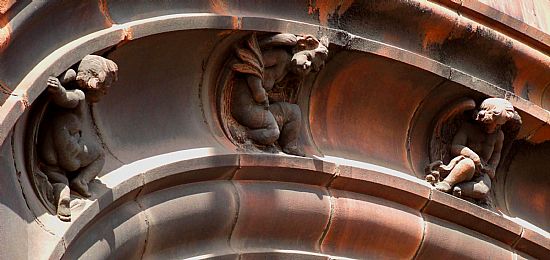215 High Street, former British Linen Bank, Glasgow
This narrow 3 storey building looks forlorn and lonely these days with the ambience of the streetscape rather bleak since its heyday. Across the narrow Nicholas Street is the Old College Bar, itself threatened with demolition for redevelopment. Across High Street are modern new office blocks and space awaiting development. (Will there ever be enough student accommodation?). As the High Street sweeps up towards the Cathedral though we see great red sandstone flats above shops. The area though is generally between holding its breath and renewal. And that means this building, number 215 is standing there trying to maintain its quiet dignity amidst it all.

We see here a smaller version of some of the elegant commercial buildings such as in Buchanan Street. It was built in 1895 as the British Linen Company Bank. Until a while ago it housed a fruit merchant, but except for a brief respite as Glasgow's Doors Open Days HUB, it has been empty. There is residential accommodation upstairs accessed from the side street.
The building is listed as “B”. We are told that it was designed by William Forest Salmon FRIBA with Edwardian Renaissance detailing. The main frontage has an octagonal corbelled canted oriel over two floors rising up to an open cupola, a “tempieto”. This forms a pivot point from the High Street into the narrow lane. A boldly stepped front gable sports a sculpture of a female figure.
But it is the arch over the main window that I want to draw your attention to. Here we find several putti. They were a popular Victorian decorative feature derived from Greco-Roman classical mythological sources and symbolise love. The difference between putti and cherubs depends much on the artist's intentions. They are usually, but not always small boys and mischief is to be expected. If they have wings, as these do, they may well be perceived as small angels, cherubim. But putti were reputed in legend to be form-changing beings. Although ours have wings, I think of them as putti. They appear as real creatures morphing from the very red sandstone that the building is made from.
http://www.architectureglasgow.co.uk/oldcity.blcbank.215highst.html
http://www.britishlistedbuildings.co.uk/200375585-glasgow-215-high-street-glasgow#.WOld7qFrjIU
http://www.buildingsatrisk.org.uk/details/907415
http://www.speel.me.uk/gp/cherubs.htm

